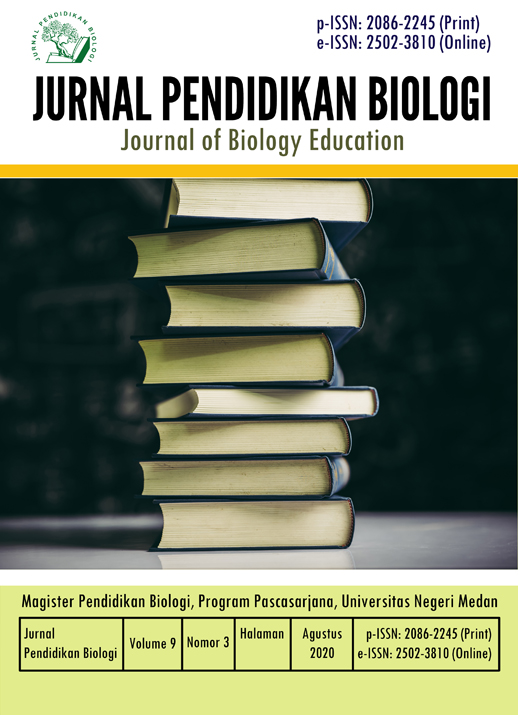Analisis Kesalahan Mahasiswa pada Penyelesaian Soal Mata Kuliah Anatomi & Fisiologi Manusia
DOI:
https://doi.org/10.24114/jpb.v9i3.17256Keywords:
Difficulties of learning, Human anatomy & physiologyAbstract
Human Anatomy and Physiology is one of the courses for biology students that is abstract so that not a few students have difficulty studying it. Errors in answering questions can be used as clues to determine the student's mastery of material. This study aims to determine student errors in solving problems in the Human Anatomy & Physiology course. This research is a qualitative descriptive study. The data collection method used is the test method. The subjects in this study were biology education students in semester V of the Nineteenth November University Kolaka Academic Year 2019/2020 who took Human Anatomy and Physiology courses. The instrument used in this study was the UAS test questions in the Human Anatomy & Physiology course. The results of the analysis showed that the most difficult questions for students to understand were questions on the function of the eye parts where the points obtained by nine students were only 2 points with the percentage of correct answers only 2%. While the questions on autoimmune disease material got the most correct percentage of answers where the number of points was nine students, namely 31 with a percentage of 34%. From the research results, it can be concluded that by analyzing student errors in answering questions, it can be seen what material is difficult for students to understand so that it can help lecturers to improve the learning process in the following semester.References
Ahi B. & Balci S. (2017). Where Does The Breath I Take From My Nose Go? Children™s Knowledge about Respiratory System. Elementary Education Online, 16(1), 326 341.
Alkan I., Akkaya G., Koksal M.S. (2016). Determining Misconceptions of Prospective Science Teachers by Using Modeling Approach as a Data Collection Way. Ondokuz Mayıs University Journal of Faculty of Education, 35(2), 121-135.
Artun H. & Costu B. (2013). Effect of the 5e Model on Prospective Teachers™ Conceptual Understanding of Diffusion and Osmosis: A Mixed Method Approach. Journal of Science Education and Technology, 22(1), 1-10.
Connor M., Lawrence A.B. (2017). Understanding Adolescents™ Categorisation of Animal Species. Animals, 7(9), 3-16.
Dogru, M.S. & Ozsevgec, L.C. (2018). Biology Subjects Which The Teacher Candidates Have Difficulties In Learning And Leading Reasons. European Journal of Education Studies. DOI: 10.5281/zenodo.1479932. 5(5): 221-232.
Etobro, A.B. & Fabinu, O.M. (2017). Students™ Perceptions of Difficult Concepts in Biology in Senior Secondary Schools in Lagos state. Global Journal Of Educational Research Vol 16, 2017: 139-147.
Marsita, R.A., Priatmoko, S., & Kusuma, E. (2013). Analisis Kesulitan Belajar Kimia Siswa SMA dalam Memahami Materi Larutan Penyangga dengan Menggunakan Two-Tier Multiple Choice Diagnostic Instrument. Jurnal Inovasi Pendidikan Kimia, 4(1): 512520.
Maras M. & Akman Y. (2009). The Understanding Level and Comprehension Mistakes of Students about Cell Biology. National Education, 181, 146-150.
Mazlum E. & Yigit N. (2017). Examining Indicators of Knowledge of Light Concept through Peer Tutoring Applications. Hacettepe University Journal of Education, 32(2), 295-311
Ong™amo, B.L., Ondigi, S.R., Omariba, A. (2017). Effect Of Utilization Of Biology Teaching And Learning Resources On Students™ Academic Performance In Secondary Schools In Siaya District “ Kenya. International Journal of Education and Research (5), 1: 253-272.
Rozek, M. & Stobaus, C.D. (2016). Teachers Dealing with Learning Difficulties
during the Process of Schooling. Creative Education, 2016, 7, 2696-2709,
DOI: 10.4236/ce.2016.717252
Subekti, A., Nugrahaningsih, Lisdiana. (2019). Implementation of the Problem Based-Fishbone Model on Reproductive System Concep. Journal of Biology Education. 8 (3) (2019) : 279-285.
Syah, M.. (2008). Psikologi Pendidikan dengan Pendekatan Baru. Bandung: PT Remaja Rosdakarya
Ustun C. & Demirci N. (2016). Biotechnology, Medicine and Ethics. Ege Journal of Medicine Biyoteknoloji, 55(3), 158-162
Downloads
Published
Issue
Section
License
Copyright (c) 2021 Jurnal Pendidikan Biologi

This work is licensed under a Creative Commons Attribution 4.0 International License.
Copyright
Penyerahan naskah menyiratkan bahwa karya yang diserahkan belum pernah diterbitkan sebelumnya (kecuali sebagai bagian dari tesis, laporan, atau abstrak). Naskah tidak dipertimbangkan untuk publikasi di tempat lain. Penerbitannya telah disetujui oleh semua penulis bersama. Jika dan kapan naskah diterima untuk publikasi, penulis masih memegang hak cipta dan mempertahankan hak penerbitan tanpa batasan. Penulis atau orang lain diperbolehkan untuk melipatgandakan artikel selama tidak untuk tujuan komersial. Untuk penemuan baru, penulis disarankan untuk mengelola patennya sebelum diterbitkan.
Open Access
Jurnal ini berkomitmen untuk membuka akses bebas yang tidak membebankan biaya kepada pembacanya atau lembaga mereka. Pembaca berhak membaca, mengunduh, menyalin, mendistribusikan, mencetak, mencari, atau menautkan ke teks lengkap artikel, selama tidak untuk tujuan komersial. Jenis lisensi adalah CC-BY-4.0.
Disclaimer
Tidak ada tanggung jawab yang dikenakan kepada Penerbit atau oleh editor untuk kesalahan dan/atau kerusakan pada naskah sebagai akibat dari pernyataan pencemaran nama baik atau dugaan pencemaran nama baik, pelanggaran hak kekayaan intelektual atau privasi, atau kewajiban produk, baik akibat kelalaian atau sebaliknya, atau dari penggunaan atau operasi ide, instruksi, prosedur, produk atau metode apa pun yang terkandung dalam materi di dalamnya.

